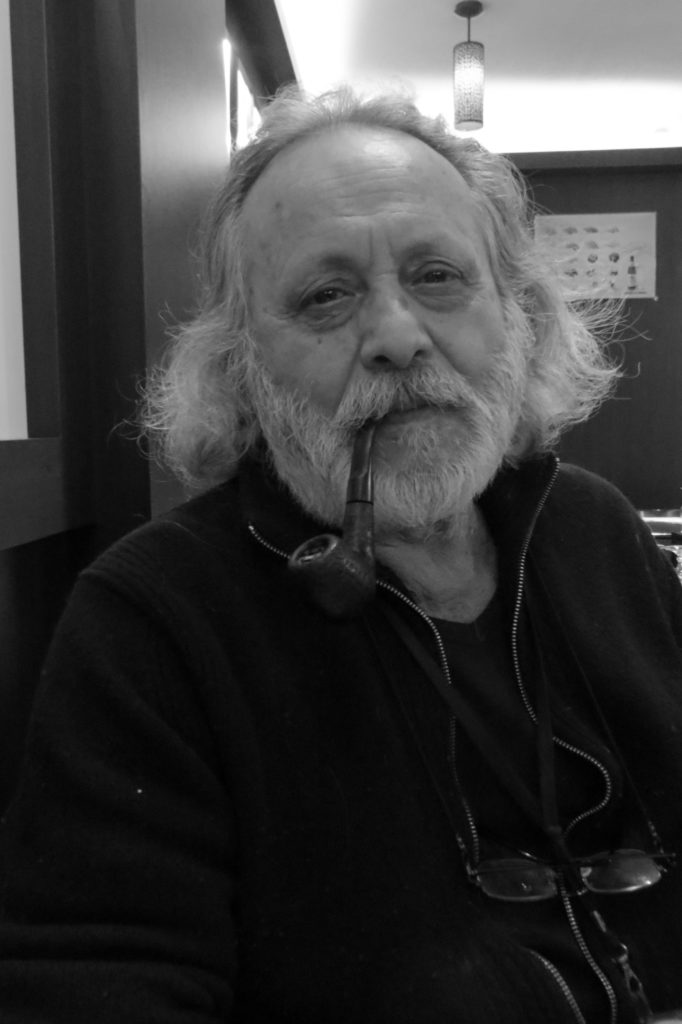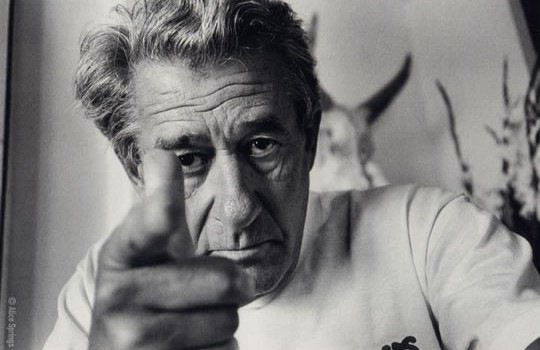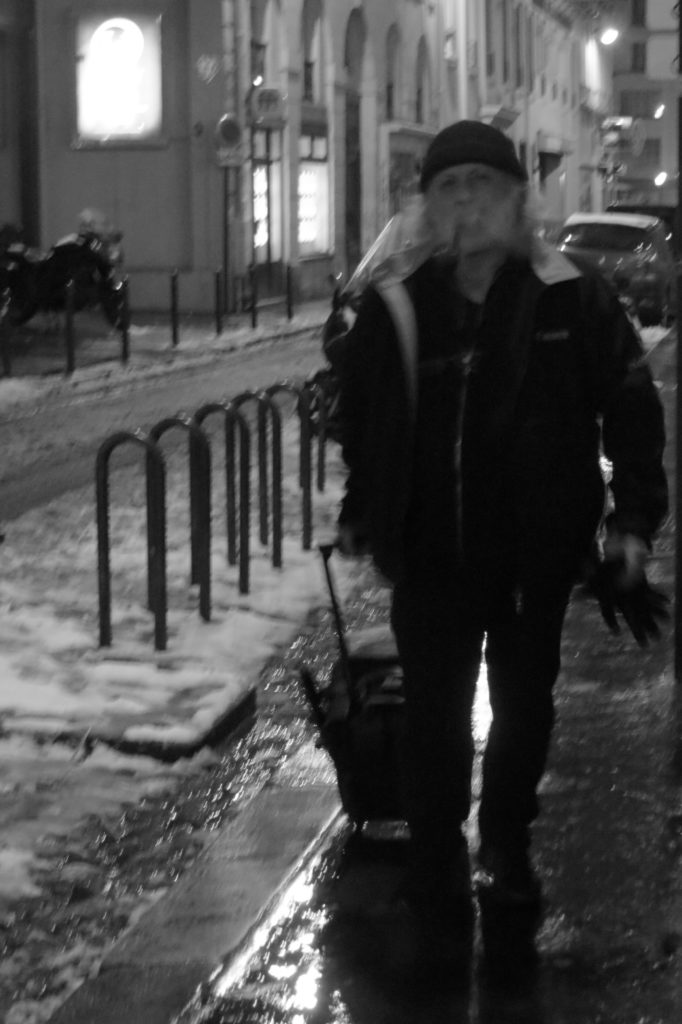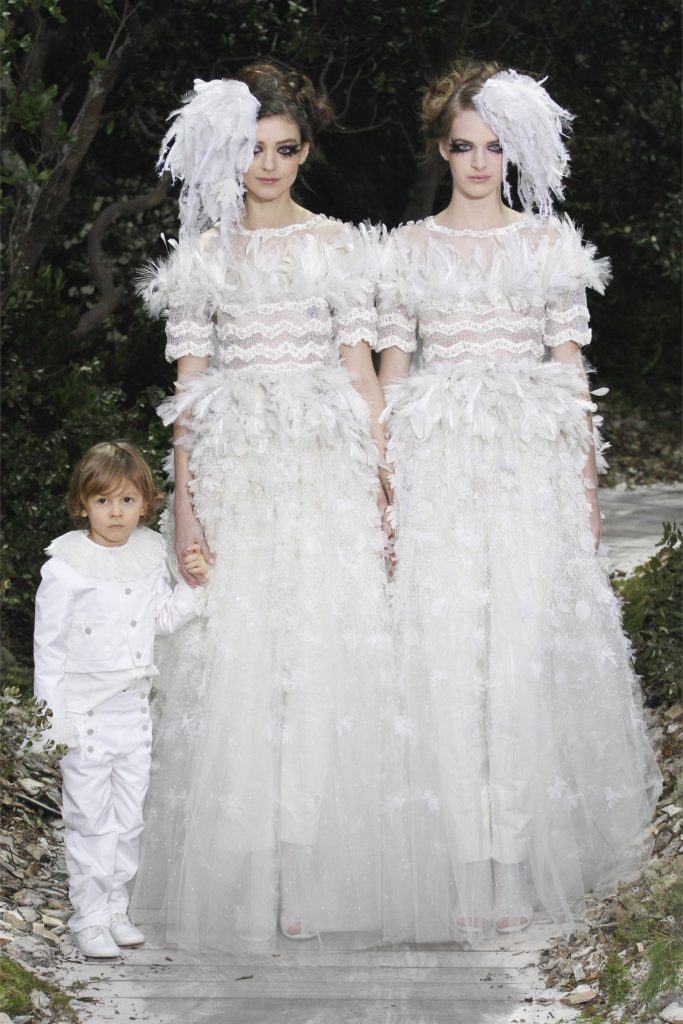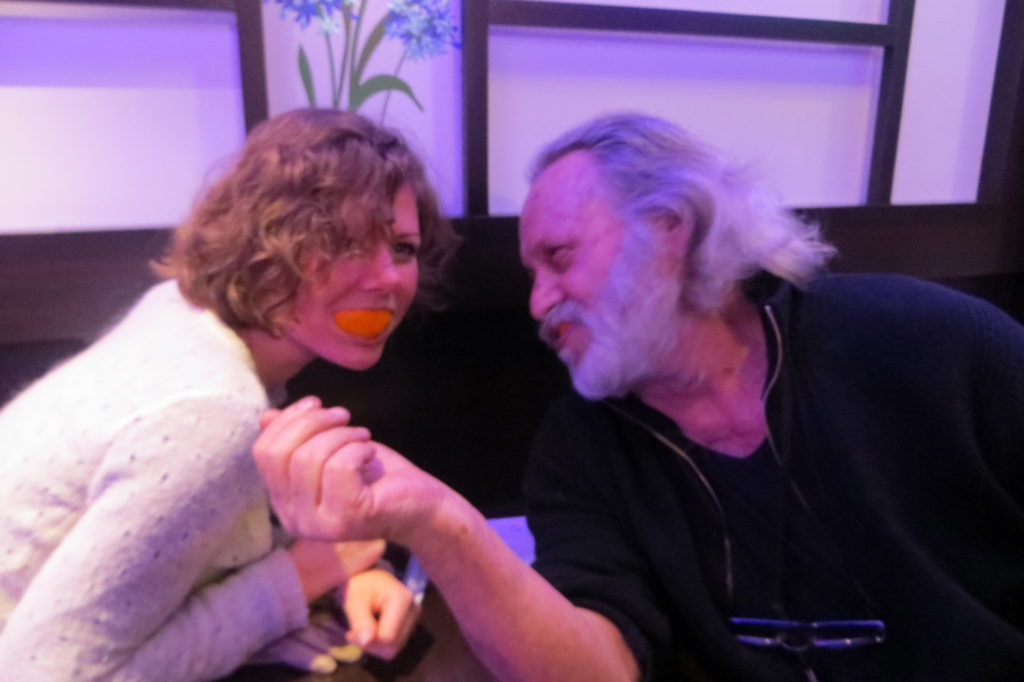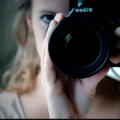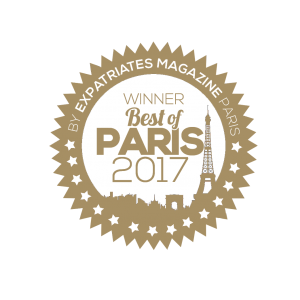Interview with Bruno Rinaldi: Photography, Helmut Newton & Vogue
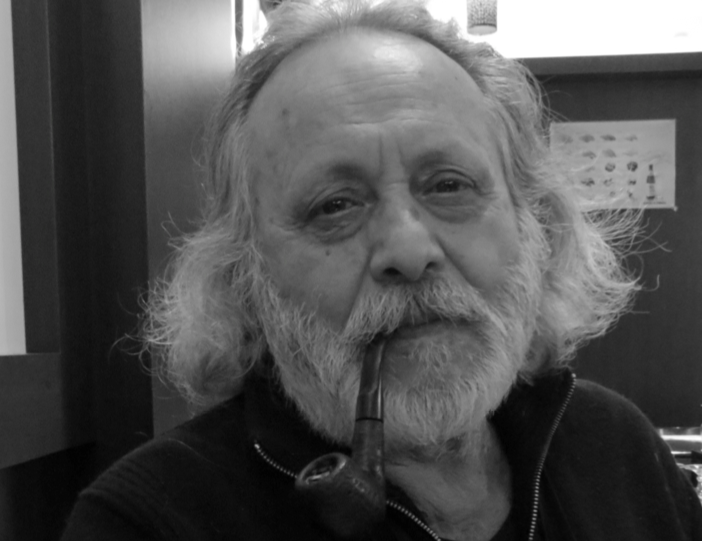
Bruno Rinaldi is one of todays most experienced fashion photographers, with more than 40 years in the fashion business. He has learned from Helmut Newton while being his assistant, worked for Vogue America and today working for Vogue Italia. He is lining up at all the biggest runway shows worldwide. It is not just his experience that makes him interesting but “an ensemble” of his outstanding and sincere character.
I´ll tell you a part of his story as he told it to me… because I think it deserves to be told. Not only because he was working for Helmut Newton, but because he has an insight, a knowledge, that I think we can learn from!
Article and pictures by Julie Johansen
Interview with Bruno Rinaldi: Photography, Helmut Newton & Vogue
I met Bruno for the first time at Versace Haute Couture show in Paris 2013. Sitting on his small chair with his camera in the right hand. He said to our mutual friend Leah: “Who is that girl?” and pointed at me. Leah smiled and introduced us. That was the beginning of my friendship with Bruno!
Dinner
After the show we went for diner, the four of us (Photographers: Bruno, Valerio, Leah and myself) at a sushi restaurant on the opposite side of “Rue de Quatre-Septembre” in Paris. This is where he told me the first part of his story.
Bruno looked at me with a smile and said: “You look like Nicole Kidman for the poor”! (Meaning: Nicole Kidman, but in a more accessible version)
We all laughed. With that statement all formal attitudes were gone.
I was sitting in front of a very straightforward and sincere man.
He looked at me and asked “Wine”?
I politely tried to refuse (I´m not that much into wine), when he said “I don´t eat with people that don´t drink!” continued by a quote: “As Hemmingway said: Never trust people that don´t drink!”
So there you go, red wine for me please! 🙂
So he started telling me his story, randomly interrupted with a “Capito?” as in “Do you understand”?
THE STORY OF BRUNO RINALDI
Bruno grew up in Rome but left for England at a very young age. He was in search for something but didn´t really know what at that time.
MOVED TO LONDON
“I left Rome very very young to go to England. I was 16 or something… and that is where everything started: my life, my photography, everything…
I was there for about 10 years – from 1965-75. … I started to notice what was going on in London. I was looking for something… but all I knew is that I wanted to learn English. You can do a lot of things with your life if you learn English. So I did that! And I was thankful, because nobody at that time spoke English… but I see that afterwards: I wanted to go ahead.”
So what did you do when you came to London?
“First I was a coffee-boy working at an Italian Café… there were a lot of journalists and one day they said: “We have an interview to make and need some pictures, would you like to come and do that for us?” So I said yes and that was the way it all started.”
“I started to know photography and became an assistant in London. It was my first real experience. At that time everybody would smoke their first hashes, everybody was having “trips”. It was fantastic.” (Bruno laughs and continues) “People were getting together to make this kind of experience. It was great. Everybody did it. It brought people together.”
BACK TO ROME
“Afterwards I went back to Rome and started photography myself – I loved photography.
“I was looking for work, because I wanted to get paid for my pictures. So I showed my book to some people/magazines that did publicity. They looked at it and said: “Would you like to come and work as an assistant for some big photographers? They are coming to shoot some campaigns and you speak English””.
“And I said yes.”
“So I started assisting for Helmut Newton amongst others… we were shooting Haute Couture in Rome in his studio.” (Around 1975-76 which was before the pret-a-porter fashion shows)
DOING CAMPAIGNS
“Did you see the big Prada campaign?” Bruno asked.
“You can make a full campaign for stupid people, or you can make a real campaign with real people… but with certain things you can not fool people.”
The Prada Campaign was a good campaign, Bruno said: “It was a picture taken in London, let´s say in September 1912: A model sitting at the table with her bag on the table: A REAL situation not a foolish thing. And you have to see the Chanel campaign. It´s a normal campaign but unbelievable!”
“The worst thing I know is “Falso ideologico” false ideas!” He said. “It would be much better having someone shooting you in the head then doing something false, capito?? That would be more human.”
WORKING WITH – AND LEARNING FROM HELMUT NEWTON
“People who were working in Helmut Newton’s studio had to learn how to paint. I was very very lucky because I had the chance to learn from one of the biggest photographers.”
I was behind the camera and Newton said “Declenche” meaning “shoot”. Newton said to me: “You focus and you make it”. The pictures were his pictures of course, not mine: He made up the stories and I just shoot them. But I learned so much from working with him.”
What did you learn from working with Newton and the other big photographers?
“When somebody acts in a very stupid way in a situation it´s finished. Especially a model or other people around! You stop working, stop everything. No more pictures that day, people could go home. People had a big responsibility for what they were saying or doing. Certain things in life you should never say or even think… one girl once came and asked what we were doing… the editor then came over to me and said “I don´t work with her anymore, it is none of her business, send her home.”
“Newton was the kind of person who knew what he wanted and knew what he did…. He instructed; “Do this, do that”.
I remember: We were doing a photo shoot of a beautiful girl coming down the stairs naked, only with a fur on… Helmut instructed her. She had to show something fantastic and never give a silly look. It was serious.”
“Newton always worked on something strong… always! The woman: To show the femininity and the strong things: always beautiful. It was never dirty, but very clean. He had a personality to do something great. He talked to the girls about his ideas and asked them what they thought about it – and they liked it – so he shot it.”
“I remember, I was also with Irving Penn: http://en.wikipedia.org/wiki/Irving_Penn
and Richard Avedon: http://en.wikipedia.org/wiki/Richard_Avedon
The main photographers for Vogue and Harpers Bazaar in the mid 40s… They were the ones that started fashion photography… it´s since them that fashion really started. They created an image of fashion.
Richard Avedon took a picture of a model with two elephants behind – no one had ever seen that before.”
“Back then, to become a photographer you had to be an assistant. It was not like now where everyone can call himself or herself a photographer… at that time we wanted a big teacher. Today nobody wants a teacher (so people know nothing).
I learned so much from being an assistant to the big fashion photographers. I learned about the picture, the human mind and the reasons.”
MAKING GOOD PICTURES
Bruno told me about photography that: “When you really want to understand something, like photography, you have to put yourself out there, go through certain things.”
“When it snows, when it´s cold and everything… you´ll have to be able to show that: For example: Today it was a shitty day in Paris. You´ll have to be able to show WHAT a shitty day in Paris is! Not just a day in Paris but a really shitty day.
In that case the idea and the theme would be: Fucked up in Paris!
If I should shoot that picture I´d leave the models shoe open (so she would freeze) then it wouldn´t be acting, but the real thing. So when you see the picture you´ll know that she was fucked up: closed and cold, and then you´ve done a picture: A story! You´ll have to show it!”
There is no doubt that photography is everything to Bruno.
PHOTOGRAPHY TODAY
“Today people know nothing about real photography. They didn´t learn from the best. They work on a computer and do bullshit. Photography is another thing: It is about talking to people; going straight to the things you need to know. It is about showing a real situation, an image. You can be homosexual etc. But show it. As a photographer you´ll have to look straight in the face of the model and see what you want to show. You´ll have to feel it!” Bruno explained.
How to make a great picture?
“The first thing you have to do as a photographer is to choose the right model: the right person for the shoot. Then you talk to her and tell her about your idea. You make a story. It could be “A confused woman”. You explain the idea and if it is a good model she will make it.”
“It is also about choosing the right location, the right light, the right situation. Then you´ll take the picture and you´ll have a story.”
“When we are talking about doing a real picture we are not talking about “stealing” the picture. Like when you go to the airport and see a plane explode and then take the picture: Everyone can do that – that is not being a photographer.
You make the picture, meaning that you have to be able to imagine the picture before taking it. If you can´t imagine the picture you´ll never make it.”
“In the construction of a picture you do an interpretation and you show it.
You have an idea… make people move, and then you show what´s going on.”
RUNWAY PHOTOGRAPHER – WORKING FOR VOGUE
After having worked with Helmut Newton and learned about photography, Bruno became a runway photographer, shooting all of the biggest shows.
What was your first fashion show? I asked.
“My first fashion show was Valentino in Rome 40 years ago. We were only 3-4 fashion photographers at that time. The other photographers came later.
To begin with it was only Haute Couture. There were only 10-12 shows. Pret-a-porter came later and started in Milan.
After a fashion show vogue America wanted to have my pictures… so I gave it to them and then they said; “why don´t you do the pret-a-porter for us as well?”
And I said; “Why not””
For how long did you work for Vogue America?
“I worked for Vogue America for about two to tree years, no more, between 1980-85… then I started working for Vogue Italia.” (For whom he still works)
ON THE RUNWAY
“On the runway it is also important to capture the atmosphere. Most photographers with their long lenses forget that. They don´t see anything: the lighting, the atmosphere… anything. For example: Yohji Yamamoto has a special light: It´s cold! If you don´t respect that you have nothing. You have to understand it. I think it is important to show what´s really going on: The atmosphere, where the show was etc. Instead of an up-close shoot where you see nothing.”
What are your greatest memories from the runway?
“There is one show I´ll never forget: Yves Saint Laurent show in 1995… with the song of Edith Piaf: “La vie en Rose” playing in the background. It was so emotional. It was magical, fantastic.”
“There was also another great show in Paris I clearly remember: The music stopped during the show but all the photographers (we were about 50) we knew the song so we started singing. We sang the song throughout the rest of the show. It was fantastic.” (Bruno lights up in a big smile) …
We had all finished our sushi and wine in the restaurant and it was time to go home. It was almost midnight and next day there would be more shows to attend. So Bruno took his little suitcase of cameras and walked through the snow towards a taxi.
NEXT DAY – PART 2
Next day I met Bruno again. He was just coming out from Chanel Haute Couture 2013 show. So I said: “Why don´t we take a coffee now and finish the interview?”
“Ok” he said.
So we went to the small brasserie behind Le Grand Palais and he told me about the show.
CHANEL AND KARL LAGERFELD
“I was pleased today… because Chanel was a fantastic show. It was real fashion: The look, the show, everything… and I was so pleased to be there.”
What made it incredible to you?
I asked
“It was Chanel: Years in front.
“This man (referring to Karl Lagerfeld), I´ll tell you why he is great: He has nothing to lose, because he doesn’t want to please anybody, he just wants to please himself. The other ones want to please the people. Also, he doesn´t have to please anybody, he is incredible.
When people go and see his fashion show, it´s like people going to see a ballet or an opera: Most people they just wait for the ballerina or opera singer to make a mistake. But Karl Lagerfeld doesn´t care if people are talking about him. And in the end he is always right!
He is not classical, but in the end he is still the most classical ever! He is great. Classical is something that won´t disturb you. You can do something different, a break-through, but in a certain moment it becomes classical.”
“As an artist, in the end, you´ll have to be an artist for you, for your person. You´ll have to respect yourself and be an artist for you. Then everything else will come.”
“Karl is a genius, because nobody can corrupt him. He doesn´t care… he says, “I like it” or “I don´t like it” and that´s it. He doesn´t say: “You are wrong” or “You are right.”
An episode with Karl
One day, during a fashion week we had a problem to shoot and Karl said: “What is the problem?”
I said: “The problem is that we can not shoot in this way”
And he said to me: “Do whatever you want, go anywhere, I don´t mind.”
That was fantastic because we didn´t bother anybody.” (I could understand that Bruno felt respected and understood.)
The conversation stopped for a while, while Bruno ordered a “Café Serré” (A strong espresso).
What do you think about the fashion world today?
“It is a language. It is serious work to everybody! If something goes wrong in the collection or in the rest you don´t sell it. If a model is bad you see it right away, if a photographer is bad you also see it… one bad campaign and you don´t do it anymore – it´s finished. It is professional work, with professional people.”
What is luxury to you?
“It is a part of the life: you have rich and poor people, I don´t care.
Being rich is also in the mind or being really rich in the heart… it has nothing to do with money. Money doesn´t make one person rich. Luxury can be a lot of things.”
<– A funny moment with Bruno!
THE END
While talking to Bruno we sometimes misunderstood each other: The Italian mood met “the scorpion”. But it all ended with a bigger understanding and three days after the Interview Bruno called me from his home in Milan, saying: “Don´t be less than fantastic, you can be incredible, I know it”!
We talked for a while and I definitely got the feeling of becoming closer to a professional and passionate photographer, an Italian… I hope you learnt something too.
Read more about Helmut Newton here.



